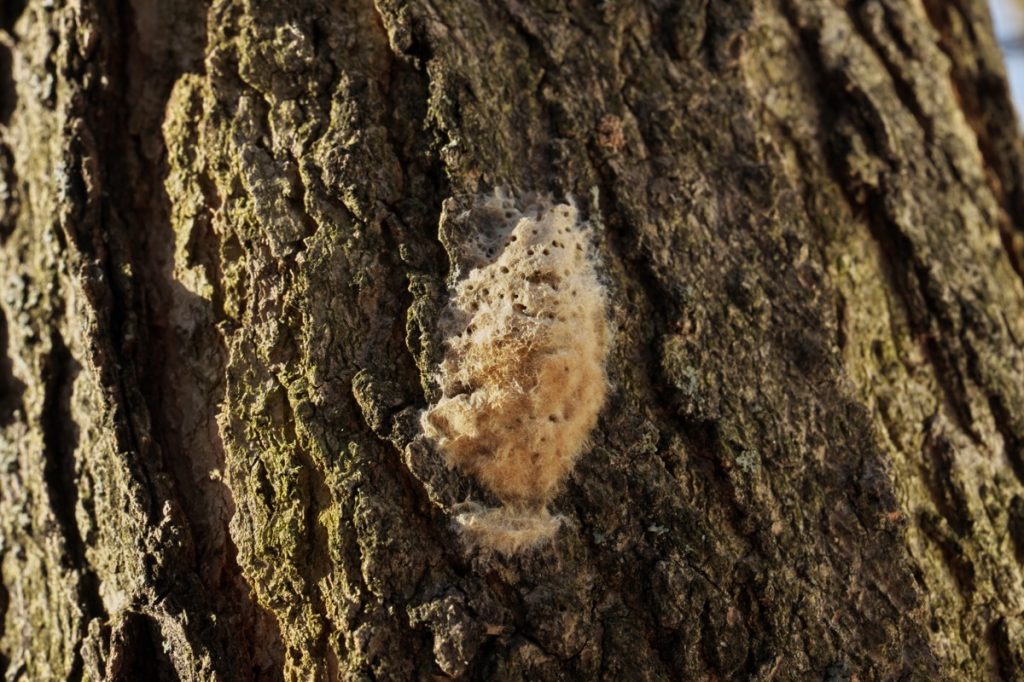The No. 1 Sign Your Yard Has Been Invaded by a Tree-Destroying Pest
Keep an eye out for evidence of this unwanted visitor.

Flowers and bushes may give your yard a unique look that you can change from year to year, but it's often the trees on your property that can really stand out. And since most take years to grow to a large size, it's especially heartbreaking to have to cut one down due to a disease or infestation killing it. That's why it's always worthwhile to take extra special care of them and ensure they're in good health—including being aware of one particular bug that could harm them. Read on to see what experts say is the number one sign that a tree-destroying pest has invaded your yard.
READ THIS NEXT: If You Have This Tree in Your Yard, Kill It and Cut It Down, Experts Warn.
Invasive species can be devastating to your yard and the environment.
Ecosystems in the United States are no strangers to invasive species. Some, like the joro spider, can remain essentially harmless as they spread throughout their newfound home. Others, such as the spotted lantern fly, can be ruinous to local plant life as they overtake new territory. But there's one longstanding invasive pest that has been an issue for homeowners and gardeners for more than a century.
The spongy moth has led a scourge on plant life since it was first accidentally introduced to Massachusetts from Europe in 1869, according to Purdue University. The invasive pest was previously known as a gypsy moth but had its name changed by the Entomological Society of America (ESA) this past March due to its use as a derogatory term for the Romani people. The bug poses a significant threat to trees as "the most serious forest defoliator in the United States," having defoliated more than nine million acres of forest nationwide, per Purdue.
For now, the invasive species is mostly found in the Northeast, but it's also spread to parts of the Midwest and into Canada, according to The New York Times. And the pest is still on the move—it could even make its way into your yard.
Experts say to keep an eye out for one warning sign.

Homeowners who take pride in their yards often notice evidence of distress in their plants or lawn that lead them to quick action. In the case of the spongy moth, experts say there's one sign to keep an eye out for that the invasive pest has arrived in your area.
"One of the most obvious signs of a spongy moth infestation is finding eggs that have been laid on or around the tree," Kevin Halbert of Winkler Tree & Lawn Care tells Best Life. "These masses or individual eggs can be placed along the branches, tree trunks, or bushes, under rocks, on fences or porous surfaces like outdoor furniture, on sheds, or even on the exterior wall of your home. Generally, eggs are placed in a location that is hard to reach for predators but gives the larvae easy access to a food source once hatched."
In fact, experts say you're most likely to notice these early stages than the pests themselves. "Eggs are one of the best signs to look for because they are visible throughout the largest portion of the year (fall through spring) and are not particularly well camouflaged," Charles van Rees, PhD, conservation scientist and naturalist at the University of Georgia, tells Best Life. "Female spongy moths lay fuzzy, silky, tan-colored sacs of eggs on vertical surfaces after breeding. You can find these in late summer, all the way through to the next spring, so looking for them can make a good winter activity when leaves no longer conceal them."
"The egg sacs vary quite a bit in size but are generally one to two inches long and about an inch wide," van Rees adds. "They look like little swollen patches of sawdust glued to your trees."
For more outdoor advice delivered straight to your inbox, sign up for our daily newsletter.
There's another sign that a serious infestation is underway.

If you haven't been on the lookout, there are other signs that the unwanted pests have made their way to your property. Unfortunately, it can also mean that some damage has already been done.
"One major sign that spongy moths have invaded your yard is finding large sections of leaves that have been eaten away," says Damon Milotte of Tailor Made Lawn Care & Pest Control. "These pests are especially fond of munching on tender new leaves, so if you find that your yard is looking a bit sparse in the foliage department, it might be time to check for eggs or larvae, which are caterpillars."
It also shouldn't be hard to distinguish what one of them looks like in its pre-moth form. "Spongy moth larvae are pretty easy to distinguish from other caterpillars thanks to the unique spotted pattern running down their backs," says van Rees. "Up front, they have five pairs of blue spots, followed by six pairs of red spots. I don't know of any other caterpillars in North America that are both fuzzy and show this sort of patterning."
Unfortunately, the bugs' ravenous appetite can do irreparable harm to your plants in the long run. "Larvae will feed on the leaves in the spring, and in the case of deciduous trees, they can regrow new foliage by summer," Chad Gore, PhD, a board-certified entomologist with Ehrlich Pest Control, tells Best Life. "They can handle defoliation for two to three successive years without dying. However, doing so reduces the tree's health, making it susceptible to insect pests and diseases."
Here's what you can do to help eliminate spongy moths from your yard.
According to experts, staying vigilant for the first signs of a spongy moth infestation and being proactive in removing them before they hatch can be the best course of action.
"When you find spongy moth egg sacs, the solution is pretty straightforward," van Rees says. "Grab a paint scraper and scrape them off the surface and into a bucket of soapy water. It should make them unviable within about 48 hours, and you can dispose of them. One nice thing about treating this species at the egg stage is that each egg case you remove may contain 600 to 1000 eggs, meaning that you're taking that many voracious caterpillars out of your yard."
If eggs have already hatched into caterpillars, you can still take action. According to Purdue University, one method is to create a "hiding tent" by securing a burlap around the infected tree at chest height and folding it half over itself, forming a skirt. Then, each afternoon, lift the cloth and brush the caterpillars into soapy water, where they should be left overnight before you dispose of them.





















